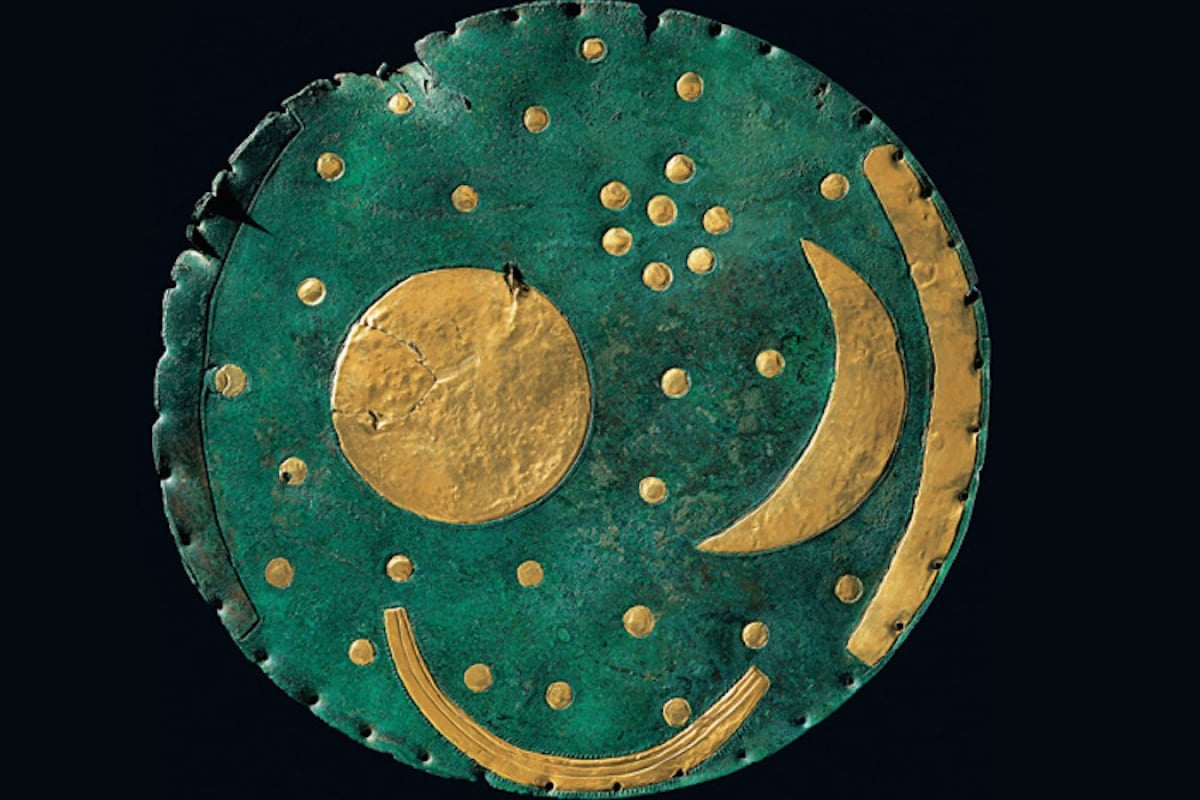
Archaeologists are questioning everything we think we know about the stunning ancient artifact known as the Nebra Sky Disc. Thought to be the oldest known depiction of the cosmos, the bronze and gold artifact may actually be 1,000 years younger than originally determined.
Archaeologists from Goethe University Frankfurt and Ludwig-Maximilian University in Munich have published a paper in the German journal Archäologische Informationen contending that the Bronze Age treasure is not from 3,600 year ago, but from the Iron Age, a millennia later.
Illegally excavated by treasure hunters in 1999, the Nebra Sky Disc is nearly a foot in diameter. There are several possible interpretations of the artwork’s cosmic imagery, but it appears to show the sun, the crescent moon, and the stars, including the Pleiades constellation, with a golden arc that may represent a solar barge or the Milky Way at the bottom. Archaeologists believe that the disc was a ritual object representing the movement of the heavens, created by the Bronze Age Únětice people to help track the lunar and solar calendars and determine when to plant crops.
Four years after its discovery, the Nebra Sky Disc was recovered from the black market during a raid in Switzerland. The looters who found it told authorities it came from a hilltop dig near the German town of Nebra, and was unearthed alongside other Bronze Age artifacts.
Bronze Age swords, axes and bracelets, supposedly found together with the Nebra sky disc. Photo by Hildegard Burri-Bayer, courtesy of the State Museum for Prehistory in Halle, Germany.
In 2013, UNESCO called the Nebra Sky Disc “one of the most important archaeological finds of the 20th century.” Now, that origin story is being called into question. In their new paper, Rupert Gebhard, director of the Munich’s Bavarian State Archaeological Collection, and Rüdiger Krause, an early European history professor at Goethe University, contend that the looters lied about where they found the artifact so that they could continue their illicit activities.
“They never tell you the place where they excavated because it is like a treasure box for them,” Gebhard told the New York Times. “They just go back to the same place to get, and sell, new material.”
Krause and Gebhard claim that soil deposits found on the Nebra Sky Disc, and the ancient weapons and jewelry supposedly found with it, don’t match. They write that the disc must be considered an individual find, and that, culturally and stylistically, it has much more in common with artifacts from the late lron Age, when “motifs of the night with stars and the moon crescent are extremely frequent.”
Excavation of a looters’ pit where the Nebra Sky Disc is said to have been discovered. Photos courtesy of Goethe University Frankfurt and Ludwig-Maximilian University in Munich.
The State Museum for Prehistory in Germany, which owns the disc, issued a statement calling the new paper’s findings “misleading” and insisting that, “from a metallurgical point of view, dating the Sky Disc to the Iron Age is clearly out of the question.”
In the past, the unique nature of the sky disc prompted speculation that the artifact is actually a modern fake. Peter Schauer, an archaeologist at Regensburg University, made headlines in 2005 by claiming the disc’s rich green patina had been artificially created using acid, urine, and a blowtorch, and that the perforations along its edges were made by a modern machine, rather than an ancient tool. He had not personally examined the artifact.
The new questions into the artifact’s origins come ahead of the exhibition “The World of the Nebra Sky Disc—New Horizons,“ co-organized by the State Museum and the British Museum in London. The show, which is slated to open in Halle next June before traveling to London in 2022, will illustrate connections between Bronze Age peoples in Britain and Germany’s Únětice culture.
Ringheiligtum Pömmelte, the German Stonehenge. Photo by Diwan, Creative Commons Attribution-ShareAlike 4.0 International (CC BY-SA 4.0) license.
For instance, the Nebra Sky Disc was made from bronze and gold originally from Cornwall, in southwest England. And it is said to have been discovered only about 60 miles south of Ringheiligtum Pömmelte, a lost ancient wooden ringed structure of the same diameter as Stonehenge discovered in 1991. Also believed to have been used in astronomical rituals and built around the same time as Stonehenge, Pömmelte has become a growing tourist attraction since being reconstructed in 2016—dubbed the “German Stonehenge” or “Woodhenge.”
“There are striking analogies between the monuments,” Joshua Pollard, a Stonehenge expert and archaeology professor at the UK’s Southampton University, told the Art Newspaper. “It seems too coincidental that the idea of creating these multiple-circle circuits should be current in both regions simultaneously.”
The State Museum plans to remove the Sky Disc from view in November to conduct restoration work ahead of the exhibition. Since first going on display 16 years ago, the artifact has brought in €24 million (about $27 million) in tourism spending to the city, according to the Local.